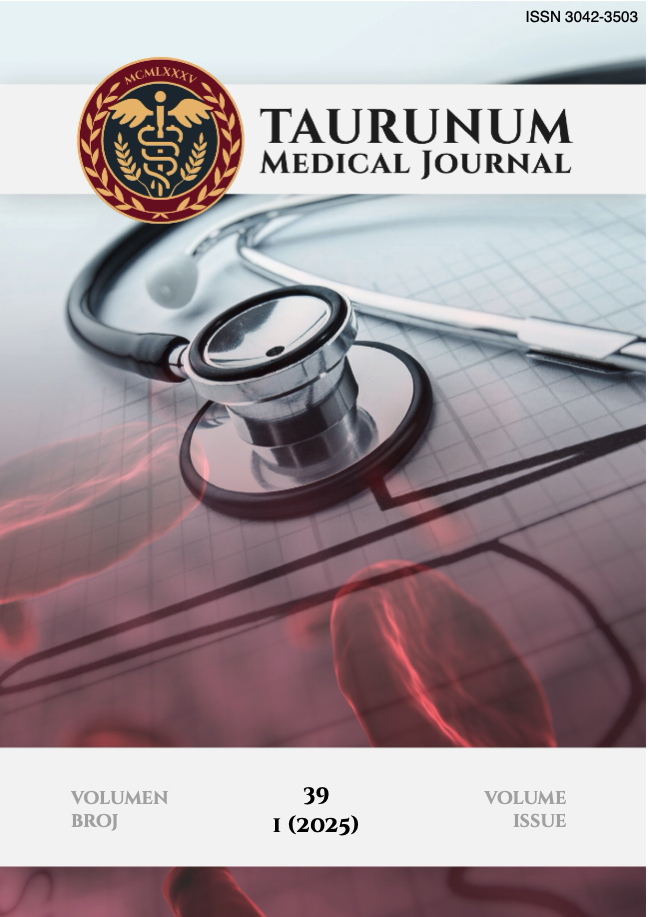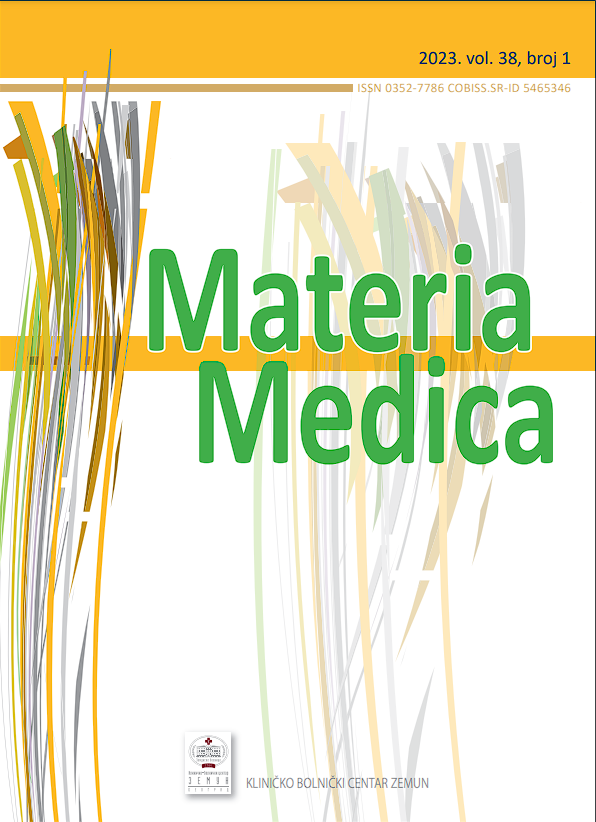Current issue

Volume 39, Issue 1, 2025
Online ISSN: 3042-3511
ISSN: 3042-3503
Volume 39 , Issue 1, (2025)
Published: 31.03.2025.
Open Access
Welcome to Issue 39, No. 1 – the first of our two annual publications for this year. Inside, you'll find a curated selection of articles. Start your year with the essential knowledge and perspectives offered in this timely edition
All issues
Contents
01.12.2017.
Review Article
Intensity modulated radiation therapy vs 3D conformal radiotherapy in the radical treatment prostate cancer: Analysis of acute and late toxicity
Implementation of IMRT offers possibility to escalate radiation therapy dose without increased acute and late toxicity. The aim of this study is to compare acute and late genitourinary and gastrointestinal toxicity in patients treated with IMRT and 3DCRT technique. This study included 35 patients in study group A treated with IMRT technique, and 35 patients in study group B treated with 3DCRT technique. Patients were selected and referred to radical radiotherapy treatment prostate cancer. Acute genitourinary and gastrointestinal toxicity was evaluated during radiotherapy treatment according to recommendation of RTOG group. Late gastrointestinal and genitourinary toxicity was evaluated during regular control exams after radical radiotherapy treatment for six months. Based on the results χ2 test there was no statistical significant difference (p>0,05) between study group A i B in terms of acute gastrointestinal and genitourinary despite escalated radiotherapy dose in study group B treated with IMRT technique. Based on the results χ2 test there was no statistical significant difference (p>0, 05) between study group A i B in terms of late gastrointestinal and genitourinary toxicity. Intensity modulated radiation therapy is optimal technique in the radical treatment prostate cancer. This technique allows clinical benefit compared with 3D conformal radiotherapy-escalation of radiotherapy dose without increased toxicity in patients treated with IMRT technique.
Slavica Marić, Ljiljana Tadić-Latinović, Branislava Jakovljević, Milan Žigić, Pavle Banović, Aleksandar Kostovski, Goran Kolarević
01.12.2017.
Review Article
Endokrine ćelije pankreasa u pacova hronično tretiranih kadfmijumom
Kadmijum (Cd) je mekan srebtrnasto-beli metal, jedan od 126 prioritetnih zagađivača, a svrstan je i u grupu humanih karcinogena I kategorije.Cilj rada je mikromorfološko i funkcionalno ispitivanje endokrinog pankreasa pacova hronično tretiranih kadmijumom. Za istraživanje su korišćeni beli Wistar pacovi ženskog pola, starosti 35-37 dana, težine 120-140 g.Ukupno je bilo 22 životinje koje su podeljene na kontrolnu (n=11) i eksperimentalnu grupu (n=11). Eksperimentalna grupa je svakodnevno tretirana sa 15mg/kg CdCl2 rastvorenog u pijaćoj vodi. Kontrolna grupa nije bila podvrgnuta nikakvom tretmanu. Svi pacovi su čuvani u kontrolisanim laboratorijskim uslovima. Posle tri meseca, sve životinje su žrtvovane. Tkivo pankreasa je rutinski obrađeno i kalupljeno u parafi n. Na 4μm presecima su primenjene HE i imunohistohemijska ABC metoda sa antitelima na: chromogranin A, insulin,glucagon,somatostatin, pankreasni polipeptid, i peptid YY. U životinja eksperimentalne grupe su nađene guste, hiperplastične B ćelije koje zaposedaju skoro čitavu površinu insule. Prisutna je i hiperplazija A ćelija sa izraženom funkcionalnom aktivnošću. Osim po obodu hiperplastičnih insula, pojedinačne A ćelije se nalaze i u acinusima u kojima je njihova aktivnost znatno povećana. Zapažen je povećan mitotski indeks i odsustvo citoplazmatskih produžetka D ćelija. Izražena je hiperplazija PP ćelija, sa znacima kako morfološkog tako i funkcionalnog polimorfi zma. Prisustvo PP ćelija je evidentirano i u hiperplastičnom i displastičnom epitelu većih duktusa. Samo u životinja eksperimentalne grupe smo našli ćelije koje sekretuju peptid YY. Ove ćelije imaju identičnu topografi ju kao i A ćelije, ali je njihov broj znatno manji. Hronično izlaganje kadmijumu remeti strukturu i funkciju endokrinog pankreasa.Sve pankreasne endokrine ćelije su pogođene.
Nina Jančić, Ivan Rančić, Janko Žujović, Velimir Milošević
01.12.2017.
Review Article
Atipična renalna cista koja imitira bubrežni karcinom: prikaz slučaja
Atipične ciste bubrega klasifikovane kaoBosniak III ili IV sususpektne na malignitet ali je u nekimslučajevima teško uspostaviti pravu dijagnozu uprkos savremenim radiološkim metodama i predložiti odgovarajući terapijski pristup. Evaluiramo slučaj komplikovane hemoragične bubrežne ciste kod 73 –godina starog pacijenta. Pacijent je primljen u našu bolnicu na dalju evaluaciju zbog nespecifičnih bolova u leđima i trbuhu i zbog hroničnih urinarnih infekcija. Ultrazvukom su verifikovane bilateralne ciste bubrega od kojih neke sa gustim sadržajem. Nakon CT pregleda jedna od tih cista je klasifikovana kao Bosniak II F, zbog diskretne opacifikacije zida ciste u jednom segmentu, dok je MR nalaz ukazao na suspektnu malignu leziju, pri čemu je opisana restrikcija difuzije intraluminalno, što ukazuje na prisustvo solidnog dela, te je pacijent nefrektomisan. Patohistološki pregled je verifikovao inflamiranu hemoragičnu cistu bez prisustva malignih ćelija. Atipična cista bubrega može odgovarati komplikovanoj cisti sa infekcijom ili krvarenjem, ali takođe i cističnom tumoru. Radiološki pregled često nije dovoljan za jasnu diferencijaciju. Lažno negativne biopsije kod cističnih promena su vrlo izvesne i često je neophodno izvršiti hiruršku intervenciju za preciznu dijagnozu.
Nataša Rakonjac, Nenad Janeski, Svetlana Kocić, Aleksandra Cvijović, Jovana Latov-Bešić, Vladimir Čotrić, Aleksandar Mandarić, Mirko Vasilski
01.12.2017.
Review Article
Möbius syndrome redefined
Moebius syndrome is rare and complex disorder which due to clinical expression poses a great challenge for pediatric anesthesiologist. The most significant problem for anesthesia, due to craniofacial malformations, is difficulties to provide a safe airway. The need for anesthesia is imposed sometime in the age of the newborn and later in childhood because of necessary diagnostic and surgical procedures. We present the case of a two-month old infant with Moebius syndrome, potential anesthetic implications, as well as the safe application of the caudal block as an anesthetics technique for operations of Achilles tendons and correction of congenital deformities of both feet.
Vesna Stevanović, Maja Šujica, Ana Mandraš
01.12.2017.
Review Article
Neurosciences and neuroimaging in service of neuroeconomics
As a consequence of significant development of neurosciences several different scientific fields as neuroeducation, neuroesthetics, nerotheology, neuromarketing etc. had been established. Neuroeconomics is interdisciplinary scientific field that has aim to explain neurological mechanisms of decision making process, mental ability of consideration of several possible alternatives, and ability to follow certain direction of action. Neuroeconomics is based on research methods, techniques and models that are overtaken from neurosciences, but also from cognitive and social psychology, as well as from experimental and behavioral economics. In practical sense, neuroeconomics is mainly involved in situations in which humans are not behaving according to rational model, but rather according to innate and adapted schemes of behavior and due to their strong emotional reaction. In this way, knowledge from the scientific fields of neurology and neurosciences that are obtained mainly by usage of neuroimaging, are used in example to investigate market or to determine functioning of employees in critical situations. This kind of practical approach opens several ethical and legal dilemmas..
Dragan Marinković, Veljko Samardžić, Tatjana Marinković
01.12.2017.
Review Article
Karcinom dojke u Pirotskom okrugu u periodu od 1998-2017 godine
Karcinom dojke je najčešća maligna neoplazmu u žena, čini oko 25% svih svih malignih bolesti i 15% svih smrtnih slučajeva, u ženskoj populaciji. Cilj našeg rada je ispitivanje učestalosti karcinoma dojke u pirotskom okrugu u periodu od 1998-2017 godine. Za ispitivanje smo koristili histopatološke izveštaje Službe za patologiju Opšte bolnice u Pirotu. Istraživanjem je obuhvaćeno 573 pacijenta operisana od karcinoma dojke u periodu od 1998-2017god. Analizirani su broj obolelih,vreme nastanka bolesti, starosno doba pacijenta u vreme dijagnoze, pol i histopatološki tip tumora. Za ispitivanje statističke značajnosti između grupa korišćen je Studentov t test. Karcinom dojke je verifikovan u 558 (97.38%) žena i u 15 muškaraca (2.62%). Prosečna starost žena sa karcinomom dojke u vreme dijagnoze je 62 god, a prosečna starost obolelih muškaraca je 64 godine Najveća učestalost karcinoma dojke zabeležena je u 2017 godini, pri čemu je zapažen statistički značajan porast broja obolelih od 2007 do 2017 godine. U radu se diskutuje o mogućim patogenetskim faktorima koji su uticali na signifikantan porast incidence karcinoma dojke u pirotskom okrugu.
Tomislav Jocić, Nina Jančić, Milena Vuletić
01.04.2018.
Special Session: Residents Session
Early changes in the neurogenesis in the subgranular zone of the hippocampus in 5xFAD transgenic mice model of Alzheimer s disease
Aim: The aim of this study was to investigate the expression of Sox1 and Sox2 transcriptional factors in the subgranular zone (SGZ) of the hippocampus in 8 weeks old 5xFAD mice. Introduction: Transgenic 5xFAD mice represent a model of Alzheimer s disease (AD) characterized by an early deposition of amyloid plaques which disrupt the process of adult neurogenesis in the hippocampus. Certain transcriptional factors such as SoxB1 transcriptional factors are involved in the process of adult neurogenesis, but their roles in neurodegenerative disorders are not fully understood. Material and Methods: Transgenic mice of both genders and their respective non-transgenic controls (n=6 per group) were used in the study. Proliferating cells and immature neurons were detected by their immunohistochemical expression of Ki67 and doublecortin, while neuronal stem/precursor cells were identified by the expression of Sox1 and Sox2 proteins. Immunohistochemistry and counting were performed on hippocampal paraffin sections. Results: Immunohistochemical analysis showed that 5xFAD mice in the SGZ of the hippocampus have significantly lower numbers of Sox1 immunoreactive cells, while Sox2 immunoreactive cells were lower only in female 5xFAD mice. Furthermore, we have detected a decrease in the number of newly formed neurons in male transgenic mice, while the number of proliferating cells was unchanged when compared to non-transgenic controls. Conclusion: The results of our study show that early changes in the neurogenesis in 5xFAD model occur despite the preserved proliferative potential in the SGZ. Our results clearly indicate the importance of SoxB1 transcriptional factors in the early phases of AD.
Ivan Zaletel, Milka Perovic, Mirna Jovanovic, Marija Schwirtlich, Milena Stevanovic, Selma Kanazir, Nela Puskas
01.04.2018.
Special Session: Residents Session
Detection of co-expression of ATRX and HIF-1alfa in renal tumors - pilot study
Aim: To investigate co-expression of ATRX and HIF-1α in kidney neoplasm in relation to its origin. Introduction: A heterogenous group of kidney tumors is believed to arise from a variety of specialized cells along the nephron – proximal tubules [Clear cell Renal Cell carcinoma (ccRCC) and papillary RCC (pRCC)] and collecting tubules [chromophobe RCC (chRCC) and oncocytoma]. ATP-dependent helicase (ATRX) is a chromatin remodeling protein involved in gene regulation and aberrant DNA methylation during cancerogenesis. Activation of hypoxia inducible factor (HIF-1α) is an early event in most RCC following inactivation of the VHL tumor suppressor gene. Material and Methods: A total of 46 kidney tumors (n=33 ccRCC, n=1 mRCC, n=4 pRCC, n=5 chRCC and n=3 oncocytomas) was immunohistochemically analyzed for ATRX and HIF-1α expression. Results: Diffuse and focal positivity of ATRX expression was found in 51.5% of ccRCC, while 54.5% had HIF-1α positivity. Co-expression of ATRX/HIF-1α was not related to nuclear grade and stage of ccRCC. Metastatic ccRCC had strong expression of both markers. pRCC type II showed weak ATRX/HIF-1α expression, while pRCC type I was negative for both markers. Interestingly, all analyzed oncocytomas and chromophobe RCC were negative for ATRX/HIF-1α. Conclusion: Our results suggest that signaling pathways have different patterns of activation/suppression of ATRX/HIF-1α in oncocytomas and chRCC compared to other RCC types. Downregulation or loss of ATRX/HIF-1α coexpression in benign tumors should be further investigated in order to determinate mechanisms of ATRX/ HIF-1α signaling transport renal neoplasm with different origin.
Gorana Nikolic, Sanja Cirovic, Sanja Radojevic Skodric
01.04.2018.
Special Session: Residents Session
Prognostic significance of detection KRAS oncogene mutations in tumor tissue of patients with metastatic colorectal cancer
Aim: To determine prognosic significance of RAS oncogene mutation detection in patients with metastatic colorectal carcinoma (mCRC). Introduction: CRC is still third most common cancer of both genders and second cause of death from malignancy in Western countries. In recent years, detecting RAS mutation in mCRC tumor tissue has became an imperative in selecting patients for monoclonal antibodies targeted therapy to Epidermal Growth Factor Receptor (EGFR). Nevertheless, there is no consensus regarding prognostic relevance of determining RAS status in patients with mCRC. Material and methods: Study included 116 patients with surgicaly resected CRC at Oncology Insitute of Vojvodina between January and December 2016. KRAS mutation detection was performed in formalin-fixed paraffin embeded tumor tissue samples processed by real-time chain polymerase reaction (real-time PCR) and applyng Cobas® KRAS Mutation Test and Cobas® 4800 System for detection of mutations in codons 12/13 and 61 of KRAS gene. Results: Average age in tested population was 65 years, with a male gender predominance (66.4%). Presence of KRAS mutation was found in 50.9% patients: 44.8% in codons 12/13, 4.3% in codon 61 and 1.7% in both codons 12/13 and 61. RAS mutated colorectal carcinomas (n=59) compared with RAS wildtype colorectal cancers, were significantly associated with male gender, moderately differentiated tumors, lymphovascular invasion and local nodal metastases. Conclusion: Our results show that, beside predictive, KRAS can also have prognostic significance regarding risk assesment for lymphovascular invasion and presence of local and distant metastases.
Vasiljevic Tijana, Slavica Knezevic-Usaj, Tatjana Ivkovic-Kapicl, Ivan Nikolic, Protic Mladjan, Dimitar Jakimov
01.04.2018.
Special Session: Residents Session
Flow cytometry: a solution in diagnosis of life threatening pediatric NonHodgkin lymphomas
Aim: Evaluation of the usefulness of flow cytometry (FCM) serous effusion analysis in a diagnosis of pediatric Non-Hodgkin lymphomas (NHL). Introduction: Serous effusions are often the first, life-threatening manifestation of pediatric NHL. FCM immunophenotyping of effusions with cytological analysis could help in diagnosis of NHL, and thus enable fast initiating of cytoreductive therapy. Material and Methods: FCM analysis of serous effusions obtained from 17 children and adolescents hospitalized in Mother and Child Healthcare Institute of Serbia under clinical suspicion of NHL using the standardized panel of monoclonal antibodies: CD19, iCD79a, CD20, CD10, iIgM, kappa/lambda, iCD3, sCD3, CD7, CD2, CD5, CD4, CD8, CD1a. Cytological examination was performed on May-Grunwald-Giemsa stained slides. The results were correlated with histopathological findings of available tumor biopsies. Results: Precursor T-cell (T-III/T-IV) phenotype was confirmed in 5 samples. In 7/9 samples with mature B (B-IV) phenotype, FAB L3 cytomorphology indicated Burkitt lymphoma (BL), and in 2/8 suggested diffuse large B-cell lymphoma (DLBCL). Tumor biopsy was available in 7/14 patients and in all cases preliminary diagnosis was confirmed. In 3 patients with no malignant cells in effusions, FCM and cytomorphologicaly only reactive changes were observed, and diagnosis had to be made by tumor biopsy (BL 2 patients, DLBCL 1 patient). Out of 7 patients diagnosed only by FCM and cytological analysis, 6 achieved a remission of the illness. Conclusion: FCM detects NHL cells in malignant serous effusions fast and accurate. In combination with cytological analysis, FCM is sufficient for diagnosis in most cases, allowing rapid initiation of therapy.
Nemanja Mitrovic, Gordana Samardzija, Slavisa Djuricic, Tatjana Terzic, Milos Kuzmanovic, Dragomir Djokic, Bojana Slavkovic









